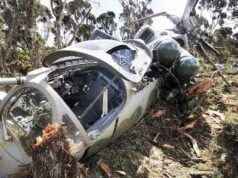 As a writer, Olusegun Obasanjo has carved a genre for himself. From his many books-“My Command” to “The Animal Called Man” et al-there is a frightening tone of military fury.
As a writer, Olusegun Obasanjo has carved a genre for himself. From his many books-“My Command” to “The Animal Called Man” et al-there is a frightening tone of military fury.
His public letters fall within the same class.
His writings are evidently tall on justifiable anger but regrettably short on facts.
On November 10, 1999, President Obasanjo wrote a letter to Governor Alamesiegha of Bayelsa State, threatening to declare a state of emergency in the state. Part of the grounds he gave for his threat was a rape incident in Choba where soldiers had allegedly gone on a raping spree, accompanied by photographers who dutifully took shots of their animal acts. The obscene pornographic pictures-with soldiers in uniform doing their thing-were put in wide circulation.
Whether the whole thing was stage managed or true is outside our scope today. The fact remains that Choba is in Rivers and not Bayelsa State. So, our President was threatening to punish a Governor and a State for an act which took place outside its borders!
The Presidential anger over the incidence at Choba had not abated and may in fact have been responsible for a full scale military invasion ordered by the President on a Bayelsa community that was accused of killing soldiers and policemen. As a result of that order, Odi, a tiny and sleepy community was completely razed down and many innocent civilians killed. That was late in 1999.
Two years after, in 2001, the President gave a similar marching order. This time a whole Senatorial Zone in Benue state was invaded.
Like in the case of Bayelsa, the Benue community was punished because of the death of some soldiers. But unlike in Bayelsa where the invading soldiers claimed they were pursuing unknown murderers, the identity of those who killed the soldiers in Zaki Biam was well known.
For, in a bewildering demonstration of criminal naivety, the murderers invited photographers and posed for photo shots with their victims and also of their butchering that followed!
At the National burial arranged for the murdered soldiers, Obasanjo announced that he had ordered security agencies to “fish” out the murderers. This was an easy task to perform since the identity of the murderers was exposed by the bizarre pictorial sessions they engaged in before and during the murders.
The truth is that the soldiers were not sent to fish out the killers as advertised. They were sent on a revenge mission.
The Nigerian media has wrongly termed what happened in Benue that year as the ‘invasion of Zaki Biam.’ The truth however is that Zaki Biam is just the headquarters of Ukum-a Local Government in a senatorial zone of six Local Governments. This whole zone was cordoned off by soldiers with an armada of armored tanks that were given air cover by helicopter gunboats.
The military juggernaut then proceeded to unleash systematic terror on unarmed civilians, a type that has not been heard of in Nigerian history.
The Human Rights Watch did a very detailed and painstaking report on the invasion. It includes the atrocities at Gbeji where soldiers gathered unarmed people in the market square, supposedly for a peace meeting and shot many of them at point blank range to death. Others at the gathering were shot in the legs, drenched in petrol and then set ablaze–incinerated alive! Over a hundred people died in this incidence alone.
A special target for the invading army was the country home of Obasanjo’s former Chief of Army staff General Victor Malu. A few months before then, he had disagreed with Obasanjo over military issues and was dropped. His family house at Tse Adoor in Katsina Ala local Government was raced to the ground; his mother of over 80 years was drilled and beaten while his blind uncle of over 90 years was thrown into a burning house where he roasted to death as his shocked wife watched. She was later shot to death.
Roadblocks were mounted and Tiv tribesmen who were travelling in vehicles brought down and shot. In fact, the damage done to human life at Zaki Biam was minimal because as news of the mass slaughter of Tiv men by soldiers spread, they all fled the town into the bush. Still the soldiers made sure they leveled all buildings in Zaki Biam, including that of Hon Benjamin Chaha, former Speaker House of Representatives.
Obasanjo never went to see the damage that was done by his soldiers but he allowed his Vice President Atiku Abubakar to go. The Vice President expressed horror at what he saw. Chuba Okadigbo, then Senate President also went and in disbelief said the brutality used to destroy Zaki Biam was not used even during the Biafra civil war.
The first reaction of President Obasanjo was to deny the involvement of Nigerian soldiers in the massacre. Then as evidence became irrefutable, he argued that what happened in Benue is what people should expect when they kill soldiers.
Due to domestic and international pressure, Obasanjo’s reluctantly set up a panel under Justice Okechukwu Opene to investigate communal disturbances in Benue, Plateau, Nassarawa and Taraba states. It looked like a diversionary panel, still, people cooperated with it and by 2003, it submitted it’s report.
The report went the way many other panels set up by governments in Nigeria go–thrashed and forgotten.
It is believed that the government of Obasanjo refused to release it because it said one or two things in its conclusions that were not in favor of his government. This was reinforced by the fact that his successor, Umaru Yar’adua and his army chief tendered a public apology to the people of Benue for the conduct of the military during the massacre.
The massacre also attracted litigation. Dr Alexander Gaadi who claimed to have suffered physical torture, loss of property and relations during the invasion took the government to court and won his case. A Federal High court in Enugu granted him the over 40 billion Naira he claimed as damages.
The military invasion of Benue is one issue Obasanjo hardly talks about in public.
On January 1, 2003, he gate crashed into an obscure local church in Makurdi and apologized for the massacre. On February 14 2003, Valentines day, he told his audience at IBB square in Makurdi that he launched his re-election campaign on that day because he wanted to show the Benue people how much he loves them. He also wanted to ask for forgiveness over the massacre.
Strangely enough, in 2011 he traveled to Makurdi and announced that George Akume, the former Governor of the state–who has never been an army commander-should be held responsible for the massacre.
But, the greatest evidence that Obasanjo treats facts and figures with contempt is to be found in General Alabi Isama’s book-“The tragedy of victory.”
Large sections of the book are a point by point rebuttal of Obasanjo’s claims in his first book, “My Command.”
General Alabi argues his case with great details, illustrating every point with maps, pictures and statistics. This book has finally put a lie to Obasnjo’s pompous claim that the civil war came to an end because of his lone military exploits.
Of particular interest to me is the claim by General Alabi that Obasanjo was a blundering General who often led his troops to doom. After one particularly disastrous battle, he says, Obasanjo took to his heels and was shot in his buttocks by the Biafrans.
Obasanjo has, of course, denied the embarrassing charge. But whenever I meet Obasanjo, I will play the doubting Thomas and ask him to strip down and show me his buttocks. Just to be sure.








